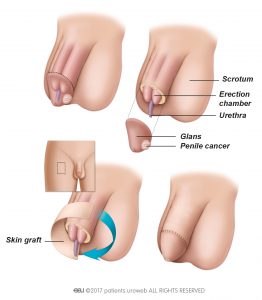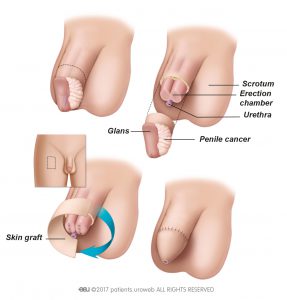Surgery
The aim of all surgery is to preserve as much of the penis as possible while removing all of the cancer. Surgery will change the appearance of your penis and you should discuss how the penis may look after surgery with your surgeon. It may take up to 3-months for the penis to fully heal and its appearance will improve over time.
If you are finding it difficult to prepare psychologically for surgery, you should consider asking to be referred to a cancer counsellor to talk through your fears and concerns.
Glans resurfacing
This involves removing the surface tissue from the end of the penis and taking biopsies from deeper within it to check for cancer. A small section of skin may be removed from the thigh and used to replace the area of the penis which has been affected (skin graft).
Partial Glansectomy
This is the removal of part of the head of the penis (glans) that has been affected by cancer. It may be suitable for smaller tumours occupying less than half the head of the penis. The surgeon can rebuild the part of the penis that has been removed, using part of the foreskin, shaft skin or by using a skin graft.
Glansectomy
This is performed for cancer that is confined to the end of the penis (glans penis) and involves removing the whole of the glans. To make the penis look as normal as possible after surgery skin may be taken from the thigh and used as a skin graft to make a new glans. Alternatively, the foreskin may sometimes be used if it has no cancerous areas. This can achieve a good cosmetic result, but the penis will be shorter than before surgery.
Partial Penectomy
This is surgery to remove more of the penis than just the end. Skin may be taken from another area of the body such as the thigh to replace the part of the penis which has been removed (skin graft).
Total (Radical) Penectomy
This is an operation to remove the whole of the penis. The urethra or water pipe will be used to make a urinary passage called a perineal urethrostomy. This will mean that men will need to sit down on a toilet to pass urine. The sensation or need to pass urine should not be affected.
After Surgery
After Surgery (in all cases)
After your surgery it is important you follow instructions given to you by your specialist team.
- Painkillers should be taken regularly as prescribed.
- The penis will have surgical dressings covering it which will usually be left in place for up to 5 days. Doctors and nurses will check these dressings and the site of the operation regularly for bleeding or infection. Baths or showers should be avoided during this time, and you may be advised to have a salt bath after 14 days. You should pat the operation site dry with a clean towel or gauze and avoid any material that may leave fibres on the site. Alternatively, a hairdryer on a cold setting can be used to gently dry the area.
- If a graft has been taken from the thigh a waterproof dressing will be applied which will need to remain on for 2-weeks. As the site of the skin graft heals it may cause an unusual odour which can cause alarm, but this is us a result of the natural healing process. You should be aware that the colour of a skin graft may be a slightly different colour to the normal colour of your penis.
- Stitches will be dissolvable but may take 4 – 6 weeks to dissolve.
- You will need a minimum of 4 weeks off work.
After Surgery (glansectomy, partial penectomy)
- You will need to remain in bed for up to 48 hours after the operation (this is called bed rest) to allow the skin graft to join to the penis.
- To protect the urethra (water pipe) from becoming damaged during surgery a urinary catheter (urine drainage tube) will be inserted into the bladder. This will need to stay in for 5 – 7 days. Information about urinary catheters can be found here. This also gives the skin graft on your penis a chance to heal.
After Surgery (total penectomy)
- Blood or fluid can sometimes gather at the operation site and a small plastic tube(s) called a wound drain(s) may be inserted during the operation. This will allow excess fluid to drain naturally and healing to take place. The wound drain(s) will usually be removed after 24 hours.
- To protect the urethra (water pipe) from becoming damaged during surgery a urinary catheter (urine drainage tube) will be inserted into the bladder. This will need to stay in for 7-14 days. Information about urinary catheters can be found here.
- You will need to avoid strenuous activity such as heavy lifting/ shopping and gardening for 4 – 6 weeks after surgery while the wound heals. You may need to wear anti embolism stockings (anti blood clot stockings) to protect the circulation in your legs for some time after the operation. Blood thinning medication may also be given in the form of injections.
The areas of the penis which have been removed during surgery will be analysed in a laboratory to see how cancer has affected them. It may take a few weeks for the results to be ready. You will then be informed of the results and whether any further treatment is needed.
Lymph Node Dissection
Inguinal Lymph Node Dissection
This involves removing the lymph nodes from one or both sides of the groin. It is performed under a general anaesthetic and may take 2 – 3 hours. A cut is made into the groin and lymph nodes are removed for laboratory analysis. Blood or fluid can sometimes collect around the operation site. To prevent this from slowing the healing process, a small plastic tube called a wound drain may be inserted near to the operation site to allow this fluid to drain away. It is usually removed after 2 weeks but may need to remain in place longer.
Pelvic Lymph Node Dissection
This operation is used to remove lymph nodes from the pelvic area. It is commonly performed by laparoscopic surgery (keyhole surgery). Blood or fluid can sometimes collect around the operation site and to prevent this from slowing the healing process, a small plastic tube called a wound drain may be inserted near to the operation site to allow this fluid to drain. It is usually removed after 2 weeks but may need to remain in place longer. Recovery from this operation will take longer than groin surgery.
After surgery
- Painkillers should be taken as prescribed on a regular basis.
- It will take some time for your body to fully recover from this operation and you will need to avoid strenuous activity for 4 – 6 weeks after surgery.
- A well-balanced, high protein diet will help the wound heal.
- A nurse may visit you at home and check that the operation site remains clean and healthy.
- The wound will have stitches which will gradually dissolve, this may take up to a month.
You may have a urinary catheter placed into your bladder to allow urinary drainage. Information about urinary catheters can be found here.
Lymphoedema
Surgery to the groin or pelvic lymph nodes can reduce the drainage of lymph which will cause swelling in the groin, legs, and the scrotum and is called lymphoedema. Lymphoedema can cause pain and discomfort and will need to be treated by the medical team. Most lymphoedema can be managed and may improve over time, but sometimes it will affect men for life. More information on lymphoedema can be found here.
Penis Reconstruction (Phalloplasty)
If no cancer has returned after 5 years, it may be possible for some men to have a “new penis” reconstructed. This procedure is known as phalloplasty. It requires several specialised operations and is only carried out in a few hospitals throughout Europe.
There are slightly different ways of reconstructing a new penis, but it usually requires three stages or operations with a gap of around 3-months in between each surgery. This means that it may take 18 months to complete.
Stage 1
Skin from the forearm, thigh or abdomen will be removed to create a new penis and urethra (water pipe). This will then be attached to the area where the penis was.
Stage 2
The skin used to create the new penis will be shaped to resemble a normal penis and the remaining urethra may be joined to the new urethra.
Stage 3
Although the new penis will look more normal there will be a loss of sensation. It will not be possible for men to have a natural erection. To enable men to have an erection a special type of tube will be inserted into the body of the penis (penile prosthesis). This is usually inflatable and can be inflated by pressing a button which will be concealed in the scrotum.
Like any surgery there are risks of bleeding and infection and skin graft areas will need to be closely monitored to ensure they are healing. This may mean that normal daily activities will be restricted for some time. Men who may be suitable for this procedure will need to talk to their specialist team to ensure that they are aware of the potential problems associated with this surgery.



